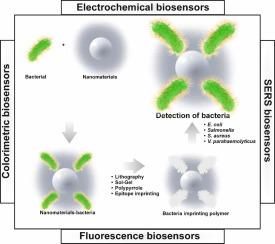基于细菌印迹聚合物的新兴病原菌生物传感器综述:有望用于选择性检测的新工具
IF 4.9
2区 化学
Q1 CHEMISTRY, ANALYTICAL
引用次数: 0
摘要
病原菌在环境中的传播是一个重大的全球性问题,对人类健康造成了严重威胁,并损害了经济发展。事实上,开发灵敏且具有选择性的病原菌检测方法对于预防和治疗感染至关重要。在这方面,作为高效分析方法的生物传感器可以发挥重要作用。重要的是,利用新策略可以提高这些生物传感平台的性能。在各种类型中,分子印迹聚合物(MIPs)作为人工受体,被开发成具有选择性和灵敏性的生物传感器。这些合成聚合物中独特的互补空腔使其具有独特的特性,因为它们是专门为各自的模板定制的。值得注意的是,细菌压印聚合物(BIPs)作为 MIPs 的一个重要而新颖的成员,因其具有许多与细菌互补的空腔而在不同细菌的检测方面引起了广泛关注。由于具有高亲和性和选择性,这些新型探针可以从食物、水或生物液体等多种样品中有效分离出各种细菌。本研究综述了 BIPs 在生物传感器结构中的应用,它是不同细菌检测领域的活跃研究领域,用于检测金黄色葡萄球菌(S. aureus)、沙门氏菌(Salmonella)、副溶血性弧菌(V. parahaemolyticus)和大肠杆菌(E. coli)。此外,还综述了细菌印迹的直接策略和先进方法。讨论了 BIPs 传感器的不足和未来展望。本文章由计算机程序翻译,如有差异,请以英文原文为准。

A review of new emerging biosensors based on bacteria-imprinted polymers towards pathogenic bacteria: Promising new tools for selective detection
The spread of pathogenic bacteria in the environment, as a significant global issue, causes a substantial threat to human health, damaging economic development. Indeed, the development of sensitive and selective sensing approaches for detection of pathogenic bacteria is essential to prevent and treating infections. In this regard, biosensors as efficient analytical methods can play an important role. Importantly, exploiting of novel strategy can improve the performance of these biosensing platforms. Among different types, molecularly imprinted polymers (MIPs), as artificial receptors, that are developed to selective and sensitive biosensors. The distinct complementary cavities in these synthetic polymers contribute to their unique characteristics, as they are specifically tailored to their respective templates. Notably, bacteria-imprinted polymers (BIPs), as an important and novel member of MIPs, attracted considerable attention for different bacteria detection due to many cavities complementary to their bacteria. These novel probes can efficiently isolate various bacteria from wide range of samples such as food, water, or biological fluids due to the high affinity and selectivity. In this study, the application of BIPs in the structure of biosensors, as active area of research in the field of different bacteria detection, was reviewed for detection of Staphylococcus aureus (S. aureus), Salmonella, Vibrio parahaemolyticus ((V. parahaemolyticus) and Escherichia coli (E. coli). In addition, direct strategies and advance methods for bacteria imprinting completely reviewed. The deficiency and future perspective of BIPs sensors were discussed.
求助全文
通过发布文献求助,成功后即可免费获取论文全文。
去求助
来源期刊

Microchemical Journal
化学-分析化学
CiteScore
8.70
自引率
8.30%
发文量
1131
审稿时长
1.9 months
期刊介绍:
The Microchemical Journal is a peer reviewed journal devoted to all aspects and phases of analytical chemistry and chemical analysis. The Microchemical Journal publishes articles which are at the forefront of modern analytical chemistry and cover innovations in the techniques to the finest possible limits. This includes fundamental aspects, instrumentation, new developments, innovative and novel methods and applications including environmental and clinical field.
Traditional classical analytical methods such as spectrophotometry and titrimetry as well as established instrumentation methods such as flame and graphite furnace atomic absorption spectrometry, gas chromatography, and modified glassy or carbon electrode electrochemical methods will be considered, provided they show significant improvements and novelty compared to the established methods.
 求助内容:
求助内容: 应助结果提醒方式:
应助结果提醒方式:


